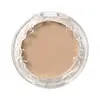KVD Vegan Beauty Good Apple Skin-Perfecting Balm Versus Anastasia Beverly Hills Impeccable Blurring Second-Skin Matte Foundation
What's inside
What's inside
 Key Ingredients
Key Ingredients

 Benefits
Benefits

 Concerns
Concerns

 Ingredients Side-by-side
Ingredients Side-by-side

Triethylhexanoin
MaskingOctyldodecanol
EmollientSilica
AbrasiveDimethicone
EmollientDibutyl Lauroyl Glutamide
Skin ConditioningOctyldodecyl Neopentanoate
EmollientDisteardimonium Hectorite
StabilisingIsostearyl Alcohol
EmollientOleyl Alcohol
EmollientPolymethyl Methacrylate
Pyrus Malus Fruit Extract
Skin ConditioningDisodium Stearoyl Glutamate
CleansingMica
Cosmetic ColorantHydrolyzed Sodium Hyaluronate
Skin ConditioningPolysilicone-11
Water
Skin ConditioningButylene Glycol
HumectantCaprylyl Glycol
EmollientPhenoxyethanol
PreservativeAluminum Hydroxide
EmollientCarthamus Tinctorius Seed Oil
MaskingHexylene Glycol
EmulsifyingTocopheryl Acetate
AntioxidantTocopherol
AntioxidantAscorbic Acid
AntioxidantDecyl Glucoside
CleansingGlycerin
HumectantSodium PCA
HumectantSodium Lactate
BufferingArginine
MaskingAspartic Acid
MaskingPCA
HumectantSaccharomyces/Magnesium Ferment
Glycine
BufferingAlanine
MaskingSerine
MaskingValine
MaskingSaccharomyces/Copper Ferment
Skin ConditioningPotassium Sorbate
PreservativeSaccharomyces/Silicon Ferment
Skin ConditioningIsoleucine
Skin ConditioningProline
Skin ConditioningThreonine
Saccharomyces/Zinc Ferment
Skin ConditioningHyaluronic Acid
HumectantSaccharomyces/Iron Ferment
Skin ConditioningSilanetriol
Citric Acid
BufferingSorbic Acid
PreservativeHistidine
HumectantPhenylalanine
MaskingTitanium Dioxide
Cosmetic ColorantIron Oxides
Triethylhexanoin, Octyldodecanol, Silica, Dimethicone, Dibutyl Lauroyl Glutamide, Octyldodecyl Neopentanoate, Disteardimonium Hectorite, Isostearyl Alcohol, Oleyl Alcohol, Polymethyl Methacrylate, Pyrus Malus Fruit Extract, Disodium Stearoyl Glutamate, Mica, Hydrolyzed Sodium Hyaluronate, Polysilicone-11, Water, Butylene Glycol, Caprylyl Glycol, Phenoxyethanol, Aluminum Hydroxide, Carthamus Tinctorius Seed Oil, Hexylene Glycol, Tocopheryl Acetate, Tocopherol, Ascorbic Acid, Decyl Glucoside, Glycerin, Sodium PCA, Sodium Lactate, Arginine, Aspartic Acid, PCA, Saccharomyces/Magnesium Ferment, Glycine, Alanine, Serine, Valine, Saccharomyces/Copper Ferment, Potassium Sorbate, Saccharomyces/Silicon Ferment, Isoleucine, Proline, Threonine, Saccharomyces/Zinc Ferment, Hyaluronic Acid, Saccharomyces/Iron Ferment, Silanetriol, Citric Acid, Sorbic Acid, Histidine, Phenylalanine, Titanium Dioxide, Iron Oxides
Water
Skin ConditioningCyclopentasiloxane
EmollientCetyl PEG/PPG-10/1 Dimethicone
EmulsifyingC12-15 Alkyl Benzoate
AntimicrobialAlcohol
AntimicrobialPolyglyceryl-4 Isostearate
EmulsifyingButylene Glycol
HumectantDisteardimonium Hectorite
StabilisingMethyl Methacrylate Crosspolymer
Bixa Orellana Seed Extract
MaskingSodium Chloride
MaskingDimethicone Crosspolymer
Emulsion StabilisingTrimethylsiloxysilicate
EmollientAluminum Hydroxide
EmollientSodium Dehydroacetate
PreservativeTriethoxycaprylylsilane
1,2-Hexanediol
Skin ConditioningCaprylyl Glycol
EmollientTocopheryl Acetate
AntioxidantSodium Phytate
Glycogen
HumectantSodium Acetylated Hyaluronate
HumectantMaltodextrin
AbsorbentCI 77891
Cosmetic ColorantIron Oxides
CI 77491
Cosmetic ColorantCI 77492
Cosmetic ColorantCI 77499
Cosmetic ColorantWater, Cyclopentasiloxane, Cetyl PEG/PPG-10/1 Dimethicone, C12-15 Alkyl Benzoate, Alcohol, Polyglyceryl-4 Isostearate, Butylene Glycol, Disteardimonium Hectorite, Methyl Methacrylate Crosspolymer, Bixa Orellana Seed Extract, Sodium Chloride, Dimethicone Crosspolymer, Trimethylsiloxysilicate, Aluminum Hydroxide, Sodium Dehydroacetate, Triethoxycaprylylsilane, 1,2-Hexanediol, Caprylyl Glycol, Tocopheryl Acetate, Sodium Phytate, Glycogen, Sodium Acetylated Hyaluronate, Maltodextrin, CI 77891, Iron Oxides, CI 77491, CI 77492, CI 77499
 Reviews
Reviews

Ingredients Explained
These ingredients are found in both products.
Ingredients higher up in an ingredient list are typically present in a larger amount.
Aluminum Hydroxide is a form of aluminum. It can be naturally found in nature as the mineral gibbsite. In cosmetics, Aluminum Hydroxide is used as a colorant, pH adjuster, and absorbent.
As a colorant, Aluminum Hydroxide may add opacity, or reduce the transparency. Aluminum hydroxide is contains both basic and acidic properties.
According to manufacturers, this ingredient is an emollient and humectant. This means it helps hydrate the skin.
In medicine, this ingredient is used to help relieve heartburn and help heal ulcers.
There is currently no credible scientific evidence linking aluminum hydroxide in cosmetics to increased cancer risk.
Major health organizations allow the use of aluminum hydroxide in personal care products and have not flagged it as a carcinogenic risk at typical usage levels.
Learn more about Aluminum HydroxideButylene Glycol (or BG) is used within cosmetic products for a few different reasons:
Overall, Butylene Glycol is a safe and well-rounded ingredient that works well with other ingredients.
Though this ingredient works well with most skin types, some people with sensitive skin may experience a reaction such as allergic rashes, closed comedones, or itchiness.
Learn more about Butylene GlycolCaprylyl Glycol is a humectant and emollient, meaning it attracts and preserves moisture.
It is a common ingredient in many products, especially those designed to hydrate skin. The primary benefits are retaining moisture, skin softening, and promoting a healthy skin barrier.
Though Caprylyl Glycol is an alcohol derived from fatty acids, it is not the kind that can dry out skin.
This ingredient is also used as a preservative to extend the life of products. It has slight antimicrobial properties.
Learn more about Caprylyl GlycolDisteardimonium Hectorite comes from the clay mineral named hectorite. It is used to add thickness to a product.
It can also help stabilize a product by helping to disperse other ingredients.
Hectorite is a rare, white clay mineral.
Learn more about Disteardimonium HectoriteTocopheryl Acetate is AKA Vitamin E. It is an antioxidant and protects your skin from free radicals. Free radicals damage the skin by breaking down collagen.
One study found using Tocopheryl Acetate with Vitamin C decreased the number of sunburned cells.
Tocopheryl Acetate is commonly found in both skincare and dietary supplements.
Learn more about Tocopheryl AcetateWater. It's the most common cosmetic ingredient of all. You'll usually see it at the top of ingredient lists, meaning that it makes up the largest part of the product.
So why is it so popular? Water most often acts as a solvent - this means that it helps dissolve other ingredients into the formulation.
You'll also recognize water as that liquid we all need to stay alive. If you see this, drink a glass of water. Stay hydrated!
Learn more about WaterThis ingredient is a combination of red, black, and yellow iron oxide pigments. This combination of colors is usually found in foundation, because it results in a "skin" color.